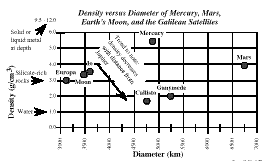
All spacecraft need to know where to go and have a way to get there. The "map" the spacecraft follows is based on celestial navigation; it steers by looking at the stars (F - Star Scanner). Using propellant (B - Retropropulsion Module), the spacecraft moves around in 3-dimensional space by spewing fluid through nozzles at high speeds (E - Thrusters) oriented in 3 different directions. The power needed to operate the instruments and computers onboard is generated from the heat of radioactive sources (C - Radioisotope Thermoelectric Generators). The hot environment (extreme temperatures, unfiltered sunlight , etc.) encountered during the trip to Venus on the way to Jupiter required extra protection in the form of G - Sun Shields. Communication (A - Low Gain Antenna) between the spacecraft and Earth is one of the key challenges we have to face because the High-gain Antenna did not open properly during flight (the shape shown above is what we think it looks like...it was supposed to unfold so that it would look like an upside-down umbrella) and thus we must rely on other equipment and new data-handling techniques for communication. Upon Jupiter arrival, the Atmosphere Probe will send data to the Galileo Orbiter using a dish (D - Probe Relay Antenna) oriented toward the planet (and away from the Earth).
The maneuver exercise can also be done using a chessboard. Chess pieces can represent different planets. A key concept of this exercise is that the shortest distance between two points is NOT always the the best way to go. To get from one side of a forest to the other you'd probably use roads on the edge of it rather than going through the middle. Maneuvering spacecraft involved even more complicated decisions. Spacecraft need to get directions (thruster firing values) from "controllers" on Earth. For safety reasons, the controllers want to know where the spacecraft is located as much as possible. Maneuvers are planned by keeping in mind the TRADEOFFS between saving propellant and staying in contact with the Earth.

This chart shows that Earth and Jupiter are VERY different in these parts of the "weather equation". It's no wonder that their weather patterns look different. (More detailed information about Jupiter's weather is available on the Galileo Poster and also in these references listed on page 14: Beatty & Chaikin, Hunt & Moore and Yeates et al)
 The Moons of Jupiter
The Moons of Jupiter
The inner Galilean satellites, Io and
Europa, are about the size of Earth's
moon. The outer Galilean satellites,
Ganymede and Callisto, are about the
size of Mercury.